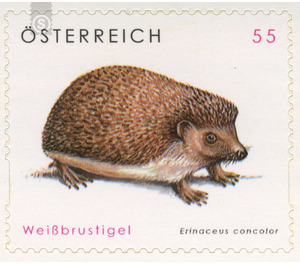animal welfare - Austria / II. Republic of Austria 2008 - 55 Euro Cent
Theme: Animals
| Country | Austria / II. Republic of Austria |
| Issue Date | 2008 |
| Face Value | 55.00 |
| Edition Issued | 650,000 |
| Printing Type | Photogravure |
| Stamp Type | Commemorative |
| Item Type | Stamp |
| Chronological Issue Number | 2065 |
| Chronological Chapter | OOS-OE2 |
| SID | 771315 |
| In 48 Wishlists | |
The hare (Lepus europaeus) inhabits large parts of Europe, North Africa and West Asia. Although cultivated steppe areas are its preferred habitat, the hares are also found in forests and in the Alps up to an altitude of 1600 m. His body length can reach up to 70 cm, his average weight is about four to five kilos. In addition to the good camouflage color of the coat but are - clearly - the long ears (the so-called "spoon"), the really characteristic of this rodent. As a highly prevalent species, the hare has found its place in fairy tales ("The Hare and the Hedgehog"), fables ("Master Lamp") and idioms ("Dread Bunnies", "Rabbit Hare") that have been handed down for many centuries , Of proverbial quality are his timidity, his speed and maneuverability. On historical alchemical representations, for example, he points the way to the philosopher's stone as the philosopher's stone, but in African narratives he is said to have a great cunning. Due to its pronounced reproductive instinct, the rabbit has become a symbol of Easter next to the egg. Apropos, keyword "curiosities of the past": For this very reason - the rabbit as a symbol of fertility - banned Pope Zacharias in 751 the enjoyment of rabbit meat. The resulting shoots should be contained ... The white-breasted iguana (Erinaceus concolor), also called Eastern European hedgehog or Ostigel, is - in addition to the brown-breasted urchin - the second hedgehog species living in Central Europe. Preferred habitats are forest edges, hedges and gardens - one finds the shy animal but also in dunes, in the heath and steppe areas, in short: As soon as a landscape offers enough hiding places for the daily rest and hibernation, it is possible that the hedgehog here settles. The body length of this "lovable journeyman" is about 22 to 30 cm, the average weight is about 1 kg. Typical of its appearance: The top of the head and the back are provided with spines, in the case of an attack, the animal can roll up into a ball - incidentally, his only "weapon" in the fight against enemies. The hedgehog is a nocturnal solitary who spends the day in a nest (caves, crevices, barns, etc.) looking for food at dusk and night. Its "favorite food" are insects, earthworms and centipedes. The white-breasted iguana is in the "Red List of Endangered Species" of the IUCN 2007. Extensive protective measures to save the species from extinction are now being implemented by most European countries.


